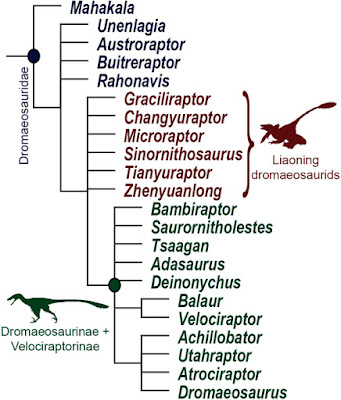 |
| Zhenyuanlong suni Lü & Brusatte, 2015
doi: 10.1038/srep11775
|
The famous ‘feathered dinosaurs’ from the Early Cretaceous of Liaoning Province, northeastern China, include several dromaeosaurids, which are among the closest relatives of birds. Most of these are small-bodied taxa with long arms and broad wings comprised of vaned feathers, but a single specimen (the holotype of Tianyuraptor) belongs to a much larger individual with reduced forelimbs, which unfortunately lacks any preserved integument. We describe a new specimen of large-bodied, short-armed Liaoning dromaeosaurid, which we designate as a new genus and species, Zhenyuanlong suni. The integument is well preserved and provides the first evidence of feather morphologies and distribution in a short-armed (and probably non-volant) dromaeosaurid, indicating that these rare and aberrant taxa had large wings consisting of pennaceous feathers on the arms and long pennaceous feathers on the tail very similar to their smaller and longer-armed relatives, but potentially lacked vaned feathers on the legs. Zhenyuanlong adds yet more diversity to the Liaoning dromaeosaurid fauna, helps further reveal a distinct short-armed bauplan among dromaeosaurids, and illuminates previously-unrecognized homoplasy that complicates dromaeosaurid phylogeny and suggests that the Liaoning taxa may not have formed their own clade.
 |
| An artist’s impression of the new short-armed and winged feathered dinosaur Zhenyuanlong suni found in China and from the early Cretaceous period (125m years ago).
illustration: Chuang Zhao || doi: 10.1038/srep11775
|
 |
| Figure 1: The holotype of the large-bodied, short-armed Liaoning dromaeosaurid Zhenyuanlong suni gen et. sp. nov. (JPM-0008).
doi: 10.1038/srep11775
|
Systematic palaeontology
Dinosauria Owen 1842.
Saurischia Seeley 1887.
Theropoda Marsh 1881.
Coelurosauria Huene 1914.
Maniraptora Gauthier 1986.
Dromaeosauridae Matthew and Brown 1922.
Zhenyuanlong suni gen. et sp. nov.
Etymology: “Long”, from the Chinese Pinyin, means dragon. The generic and specific names are in honor of Mr. Zhenyuan Sun, who secured the specimen for study.
Holotype: A nearly complete skeleton with skull and lower jaws preserved (JPM-0008), curated at the Jinzhou Paleontlogical museum. It is likely a sub-adult, as neural arches and centra are not fused in some anterior dorsal vertebrae and the sacral vertebrae, and the anterior sacral vertebrae are not completely fused to each other. The individual is fairly mature, however, as the more posterior sacrals are fused to each other and the neural arches and centra of the cervical vertebra, caudal vertebrae, and some dorsal vertebrae are fused.
Type Locality and Horizon: Sihedang of Jianchang County, Liaoning Province; Yixian Formation
 |
| Figure 4: The integument of the large-bodied, short-armed Liaoning dromaeosaurid Zhenyuanlong suni gen et. sp. nov. (JPM-0008). (A) overview of the skeleton with regions of integument indicated with grey highlight; (B) proximal tail; (C) left forearm; (D) right forearm; (E) closeup of coverts on right forearm.
doi: 10.1038/srep11775
|
 |
| Figure 5: Phylogenetic relationships of Zhenyuanlong suni among dromaeosaurid theropods.
doi: 10.1038/srep11775
|
Junchang Lü and Stephen L. Brusatte. 2015. A Large, Short-armed, Winged Dromaeosaurid (Dinosauria: Theropoda) from the Early Cretaceous of China and Its Implications for Feather Evolution. Scientific Reports. 5, 11775 doi: 10.1038/srep11775
Paleo Profile: Zhenyuanlong suni http://on.natgeo.com/1f7Bw3q via @ngphenomena
Zhenyuanlong suni: biggest ever winged dinosaur is found in China http://gu.com/p/4ayjn/stw



